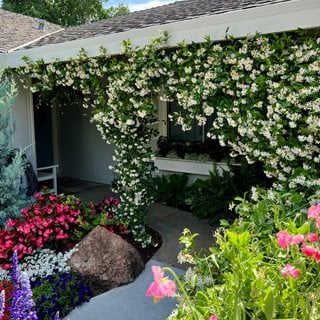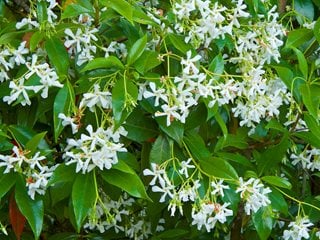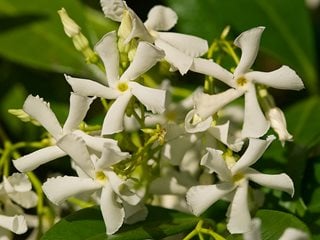HOW TO GROW STAR JASMINE PLANTS
Grow this evergreen flowering vine for sweet summertime fragrance.Jasmine is a sweetly scented vine or shrub that adds color and fragrance to the landscape. Star jasmine (Trachelospermum), a vigorous evergreen vine with intensely fragrant star-shaped flowers, blooms over a long period from late spring through summer. Despite its name, it isn’t a true jasmine, but related to oleander, periwinkle, and milkweed.
Native to China, Japan, and Korea, star jasmine is also known as confederate jasmine, southern jasmine, Chinese star jasmine, and Chinese ivy. This versatile vining plant can be grown on an arbor or other structure, as a living screen or hedging, in containers, or as a ground cover. Star jasmine is low-maintenance and virtually free of pests and diseases. Here’s how to grow and use star jasmine in your landscape.
On this page: Basics | Planting | Care | Pictures | Frequently Asked Questions | Design Ideas
On this page:
- BASICS
- PLANTING STAR JASMINE
- STAR JASMINE CARE
- STAR JASMINE VARIETIES
- FREQUENTLY ASKED QUESTIONS
- DESIGN IDEAS
STAR JASMINE BASICS
Botanical name:
Trachelospermum spp.
Zones:
7-11, depending on the variety
Exposure:
Full sun to partial sun
Height/spread:
2 to 20 feet tall and wide, depending on the variety and how it’s grown. Vertical vines can reach up to 20 feet tall, while ground covers will grow 1 to 2 feet tall.
Bloom time:
Mid spring through late summer, depending on the region and variety
Plant type and growth habit:
Star jasmine is an evergreen woody vine that can be grown vertically, pruned into a shrub or used as a ground cover. The twining growth habit allows stems to be trained up structures such as arbors, pergolas, and trellises, though the tendrils will not attach to masonry. When allowed to sprawl horizontally as a ground cover, star jasmine will develop new roots along the runners.
Foliage:
Glossy leaves are oblong-shaped with pointed ends. The foliage has dark green or variegated coloring, with some varieties acquiring hints of bronze during colder winter temperatures.
Flowers:
Star jasmine is named for the small star-shaped flowers with 5 petals. Blooms occur in clusters on new growth in shades of white, yellow, pink, or apricot. The flowers exude a heavy gardenia-like scent that becomes more pronounced on warm summer evenings.
Other attributes:
Flowers are attractive to bees. Some plants may develop long bean-like seed pods after flowering.
Is star jasmine deer resistant?
Deer are repelled by the strong fragrance, though they will eat almost anything if hungry enough.
Is star jasmine poisonous?
Star jasmine is not toxic to pets or humans, though mild digestive upset can occur if any ornamental plant is ingested.
Note: Stems exude a white sticky sap when cut, which may cause skin irritation or stain clothing. Use caution when pruning.
HOW TO PLANT STAR JASMINE
When to plant:
Plant in spring when all danger of frost is past.
Where to plant:
Star jasmine can tolerate partial shade but will flower best with at least 6 hours of full sun. Protect from afternoon sun in hotter climates.
How to plant:
Loosen soil in the planting area and amend as needed. Dig a hole slightly wider, and the same depth or just a bit shallower than the root ball. Remove plant from the nursery container and tease out roots if potbound. Place in the hole so the top of the crown is slightly higher than the soil surface (plants will settle). Fill in the hole with soil, tamp down gently to remove air pockets, and water thoroughly. Water regularly until established. Space plants 3 to 10 feet apart, depending on the variety. When used as a ground cover, space at least 5 feet apart.
For containers:
When growing star jasmine in pots, use a high quality all-purpose potting mix and plant in a 3 gallon or larger container.
STAR JASMINE CARE
Check out these care & growing tips from Janey @digplantwaterrepeat.
Soil:
Star jasmine can tolerate different soil conditions but does best in amended well drained soil with a slightly acidic soil pH of 6.0-7.0. Add compost or other rich organic matter to the soil before planting and improve drainage as needed.
Watering:
Plants perform best with regular water. Irrigate when the top 1 to 2 inches of soil feels dry. Water more frequently during prolonged heat or dry spells. Container plants will need to be watered more often. Star jasmine is drought tolerant once established.
Amendments and fertilizer:
Star jasmine needs little or no supplemental fertilizer when planted in well-amended soil. Wait until the root system is well established before fertilizing. In early spring, apply a balanced slow-release fertilizer. Avoid over-fertilizing, which may result in more foliage and fewer flowers. Apply a thin layer of compost around the base of plants each spring to feed plants, suppress weeds, and retain moisture. Yellow leaves may be a sign of nutrient deficit.
Pruning:
Star jasmine plant is amenable to pruning and can be shaped into shrubs, hedging, or espaliers. Prune and shape plants just after flowering. Because of the rapid growth rate, plants may need pruning more than once during summer or early fall. Flowers occur on new growth, so avoid pruning in spring so you don’t lose flowers for that growing season. Pinch back stem tips to encourage branching and fuller plants.
Propagation:
Star jasmine vine can be propagated by taking cuttings from established plants. Trim off a 6-inch section of a stem tip just below a leaf node. The cutting should be healthy and free of flowers. Dip the cut end of the stem in rooting hormone and place in a small pot with well-draining soil. Roots will start to develop in 2 to 3 weeks. Wait another several weeks before transplanting into the ground.
Pests and diseases:
When grown in the right conditions, star jasmine experiences few pests and diseases. Pests can include spider mites, scale, mealybugs, aphids and Japanese beetles. Diseases include leaf spot.
Overwintering:
In regions colder than USDA zone 8, container plants can be overwintered indoors.
STAR JASMINE VARIETIES
FREQUENTLY ASKED QUESTIONS
Does star jasmine need a trellis?
Star jasmine is most commonly grown on a trellis or other vertical structure, but can also be pruned into a shrub or hedging, or allowed to sprawl as a ground cover.
What is the difference between jasmine and star jasmine?
The common name of jasmine refers to a number of different flowering plants that produce jasmine-like flowers. True jasmine belongs to the genus Jasminum, while star jasmine is in the genus Trachelospermum.
What is the difference between star jasmine and night-blooming jasmine?
Native to the West Indies, night-blooming jasmine (Cestrum nocturnum) is a tropical evergreen shrub hardy to zone 10, with tubular flowers that are most heavily scented at night.
Is star jasmine an annual or perennial?
In milder regions, star jasmine is a perennial. When growing star jasmine in areas colder than USDA zones 7-8, plants can be grown in containers as an annual or overwintered indoors.
Will star jasmine survive winter?
Star jasmine can overwinter outdoors in temperatures down to 10 degrees F.
How quickly does star jasmine grow?
Star jasmine has a rapid growth rate of 3 to 6 feet in a single growing season. Asian star jasmine is slower growing.
Is star jasmine invasive?
Because star jasmine spreads rapidly through runners, it can quickly take over an area, particularly when used as a ground cover. Keep overgrown runners regularly pruned back or confine star jasmine to an area where it won’t encroach on other plants.
LANDSCAPE DESIGN IDEAS

Photo by: Janey Santos / Dig, Plant, Water, Repeat
For borders and landscapes: Use as a vine or ground cover in beds and borders.
For slopes and hillsides: Mass as a ground cover to help stem erosion.
For containers: Feature a smaller specimen in a container as an annual or perennial accent.
There are many ways of growing star jasmine in your landscape. Here’s how:
- Train this fast-growing vining plant on a lattice trellis to form a living screen between garden rooms.
- Place a climbing or container specimen near a deck or patio where you regularly spend time during warmer months to enjoy the fragrant flowers up close.
- Plant at the base of an arbor or pergola and train the twining stems up the structure for year-round shade and color.
- Use as a ground cover in a courtyard.
- Prune into a shrub, hedge, or espalier for a more formal look.
- Plant a white flowered variety in a moon garden to enjoy the reflective blooms and heavy scent on warm summer evenings.
- Mass a ground cover variety such as Asian star jasmine along a slope to help stem erosion.
- Train up an unsightly chain link fence to create an attractive living fence.
- A smaller specimen can be grown in a hanging basket and displayed on a porch or deck.
- Soften a rock wall by allowing star jasmine to cascade over the edge.














